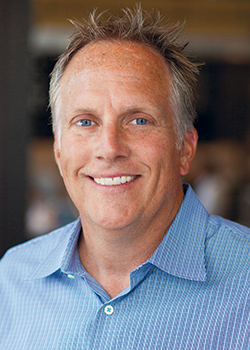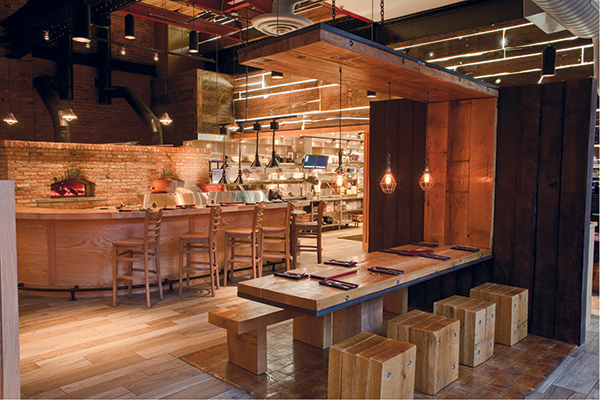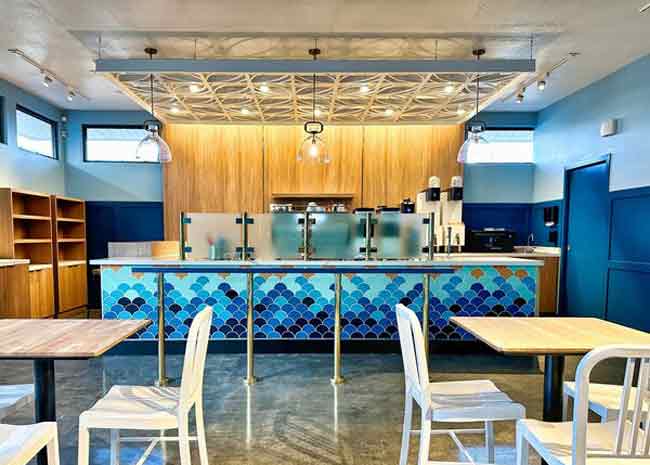Ty Neal, his brother Mark, and partners Drew Kim and Perry Smith, who left the company in 2012, opened the first Matchbox restaurant on H Street in Washington, D.C.’s Chinatown district in 2003. They rehabbed an old building themselves, transforming it into what would end up being the prototype for a casual-dining brand with staying power and growth potential.
 Ty NealToday, Matchbox Food Group operates 12 restaurants — 6 Matchbox units as well as 5 Ted’s Bulletin (vintage Americana diner) and 1 DC-3 (fast-casual hot dog joint) — with most units in and around the company’s home market. That’s about to change, however: The group plans to take its popular Matchbox concept nationwide, opening five to six new units a year. rd+d checked in with Neal for an update.
Ty NealToday, Matchbox Food Group operates 12 restaurants — 6 Matchbox units as well as 5 Ted’s Bulletin (vintage Americana diner) and 1 DC-3 (fast-casual hot dog joint) — with most units in and around the company’s home market. That’s about to change, however: The group plans to take its popular Matchbox concept nationwide, opening five to six new units a year. rd+d checked in with Neal for an update.
rd+d: Many in the casual-dining segment have struggled to remain relevant. Not so with Matchbox. What sets it apart?
TN: We hit right down the middle of the fairway, but we do it with elevated food, spirits and design. Every unit features two big handmade brick ovens right near the entrance for pizzas and oven-roasted items. We’re known for hearth-baked pizzas and mini burgers, but we also offer a wide range of chef-inspired entrées, from prime steaks to wood-roasted lamb sandwiches to ahi tuna salad. It’s fresh, scratch-made American bistro fare. There’s a chef at the helm in every kitchen and we’re absolutely fanatical about the quality of the food. I think that’s why we’re here talking about Matchbox 12 years later — because of the food.
rd+d: Design is also a differentiator. What’s been the key to getting that right?
TN: Between the partners there’s a real passion for design and we’re very hands on. We got our start by tricking out beautiful, old brick buildings in steel and hardwood. We made awesome, hand-built brick ovens the stars (in our restaurants) and created a warm and comfortable vibe — not tragically hip, just really cool environments with a contemporary, urban-industrial feel. We don’t build plastic restaurants; we build authentic restaurants with great reclaimed materials and a focus on authenticity. We have a familiar palette of materials — a certain booth design, a certain steel design for stairwells and railings, timber beam ceilings, consistent brand colors — but the application is different in each unit.
rd+d: Is it tough to maintain that authenticity as you grow?
 TN: We’ve invested in being able to maintain the attention to design detail that is so crucial to the Matchbox brand. We even have our own design shop — we call it our Disney studio — and our own artist-in-residence who does all of the welding and fabricating. She creates our custom fixtures and signature design features, and we rehab all of the steel and wood for our units there. We’re not just going through a catalog to select things like light fixtures and window frames — we’re creating our own. There’s a unique quality to these items and you can feel that in the design of the restaurants.
TN: We’ve invested in being able to maintain the attention to design detail that is so crucial to the Matchbox brand. We even have our own design shop — we call it our Disney studio — and our own artist-in-residence who does all of the welding and fabricating. She creates our custom fixtures and signature design features, and we rehab all of the steel and wood for our units there. We’re not just going through a catalog to select things like light fixtures and window frames — we’re creating our own. There’s a unique quality to these items and you can feel that in the design of the restaurants.
rd+d: Matchbox has grown in a very grass-roots way. Is that changing?
TN: It is and it isn’t. From an infrastructure standpoint, it has changed dramatically. About three and a half years ago, Chris Sullivan, who founded Outback Steakhouse, and Bill Allen, Outback’s former CEO, became minority investors and joined our advisory board. We had six or seven units at the time and they wanted to help us grow. One of the first steps was to develop a management structure to enable that to happen. We were three entrepreneurial guys wearing all the hats and figuring things out as we went, but we’ve since invested mightily in filling out an organizational chart with some very talented, experienced people. In addition to our CFO and COO, our pedigreed executives, we have a construction and development department, real estate, learning and talent team, marketing, HR. When I write my book about how to go from a crazy, seat-of-the-pants endeavor to a professionally managed and organized company, that process will take up at least a couple of chapters.
rd+d: How about your approach to raising capital?
TN: Our growth to date has been largely financed through a friends and family investment group. It’s basically a group of local D.C.-area folks who love the brand and want to participate in its growth. We’re now in our sixth or seventh capital raise over the past eight years and the group has gotten bigger each time. Many in the group have invested multiple times. We’ve been able to raise just shy of $20 million so far. So while we’ve been able to maintain that financing structure to date, the strategy will likely change as we grow larger.
rd+d: Your real estate roots are in adaptive reuse. Will that continue?
TN: When we can, yes, but we’ve definitely broadened our approach. We’ve proven that we can do urban renovation, which is how we started, but we can also do freestanding locations, lifestyle centers, new construction. Our development team is really talented. We have our own architect, a couple of seasoned guys who have built lots of restaurants throughout their careers, a senior VP of development, a couple of project managers. We’re now not only in the restaurant business but the construction business as well, and can take the brand into new markets and new types of real estate.
rd+d: What’s a typical unit cost and build-out timeframe?
TN: We spend about $500 per square foot (units average 7,000 to 10,000 square feet and seat 250) and from lease signing to opening is about a year-long process. Once we have all approvals, actual construction takes 120 to 150 days but approvals can vary greatly. For example, we got a building permit in one day in Texas and in D.C. it can take six months.
rd+d: Where is the brand headed next?
TN: We’re still opening restaurants in the mid-Atlantic market, including three that will open in Virginia by January 2016. But beyond that we’re heading to Texas and South Florida. We’ll be opening in the Preston Hollow Village mixed-use center in Dallas in late February or early March, and in the Sawgrass Mills shopping center near Fort Lauderdale in mid-2016. We recently signed a lease for Coral Gables in the Miami area, as well. We’re scouting additional locations in South Florida as well as in Austin, Houston and San Antonio, Texas.
rd+d: So you’re buckled up for a very busy year.
TN: Absolutely. It’s a fun, crazy time for us. This is a life’s dream to be able to build a company and build and operate restaurants that people love. Ours is a passionate group and hopefully we’re going to be able to take the show on the road and bring that passion to these other markets. We’re excited to do so.
While each unit is unique, the Matchbox brand aesthetic stars hand-built brick ovens, open kitchens, custom lighting, warm wood and brick finishes to create a contemporary, urban-industrial vibe.
Photos courtesy of Matchbox Food Group



